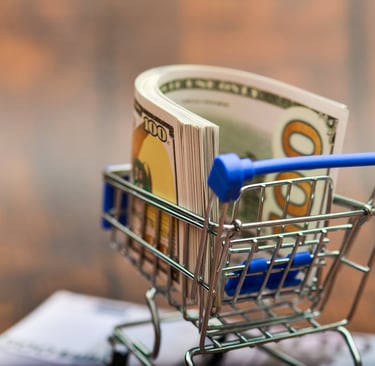Impulse Spending: Why We Do It and How to Stop
Impulse spending can quietly deplete your finances, but by understand why we do it and how to stop, you can regain control over your spending habits.
Finistack
3/19/20254 min read


Ever walked into a store for toothpaste and walked out with a scented candle, a new coffee mug, and a plant you definitely didn’t need? Yeah, welcome to the wild world of impulse spending—the sneaky budget bandit we all fall victim to at some point. While an occasional splurge can be harmless, unchecked impulse buying can wreak havoc on your financial goals faster than you can say "add to cart." So, why do we do it? And more importantly—how do we stop?
The Prevalence of Impulse Spending
Impulse spending isn’t just a "you" problem—it’s practically a national pastime. According to a 2024 survey, the average American spends about $281.75 per month on impulse purchases, which adds up to a jaw-dropping $3,381 a year (Capital One Shopping). And it’s not just small-ticket items—over 54% of Americans admit to dropping at least $100 on impulse buys, while 20% have splurged on unplanned purchases of $1,000 or more (InvespCRO). Clearly, those "treat yourself" moments are adding up!
Why Do We Impulse Buy?
Let’s face it—our brains are hardwired to love a little instant gratification. But impulse spending is about more than just being tempted by shiny things. Here’s a closer look at what’s driving those spontaneous shopping sprees:
First, there’s the emotional factor. Feeling stressed? Sad? Even super happy? Buying stuff can feel like a quick emotional fix. That dopamine rush from making a purchase provides a temporary high—but the financial hangover hits later. Stress shopping is real, and when life feels chaotic, a new pair of shoes can feel like a small victory.
Then, there’s the marketing magic. Retailers are no dummies—they know exactly how to push our impulse-buying buttons. Limited-time offers, buy-one-get-one-free deals, and eye-catching product displays all make it hard to resist. Ever wondered why gum and candy bars are right by the checkout? It’s not a coincidence.
And don’t get us started on the convenience of online shopping. With a few taps on your phone, you can have just about anything delivered to your doorstep. That ease—combined with targeted social media ads—makes impulse spending easier (and more dangerous) than ever.
Oh, and let’s not forget about the social pressure. Scrolling through Instagram and seeing your favorite influencer rave about the latest gadget or skincare product can make it tough to resist jumping on the bandwagon. FOMO (fear of missing out) is a real motivator for those unplanned purchases.
The True Cost of "Just This Once"
Impulse spending might seem harmless—until you add up the long-term costs. Those little purchases can quietly drain your bank account and derail your financial goals. Whether it’s paying off debt, saving for a vacation, or building an emergency fund, every unplanned splurge pushes those dreams further away.
Beyond the financial strain, impulse buying can also clutter your life with things you don’t really need. (How many scented candles does one person need, anyway?) Plus, many people report feeling guilty or regretful after making impulse purchases. So not only is your wallet hurting, but your mental health can take a hit, too.
How to Outsmart Your Impulse-Spending Brain
Okay, so impulse spending is a problem—but you’re not doomed to a lifetime of reckless swiping. With a few practical strategies, you can keep those impulse urges in check and still enjoy your hard-earned money. Here’s how:
Make a Budget (and Actually Stick to It) – A well-planned budget is your best defense against impulse spending. Set clear limits on how much you can spend on "fun" purchases each month, and track where your money is going.
Practice the 30/30 Rule – Got the urge to splurge? Pause for 30 hours before making any purchase over $30—and 30 days for bigger buys over $300. This cooling-off period gives you time to decide if you really need that item or if it’s just a passing whim.
Unsubscribe and Unfollow – Retailers love sending tempting deals straight to your inbox. Do yourself a favor and unsubscribe from marketing emails. And while you’re at it, unfollow those influencers who constantly tempt you to buy things you didn’t know you needed.
Make a Shopping List (and Stick to It) – Whether you’re grocery shopping or browsing online, a list is your best friend. If it’s not on the list, it doesn’t go in your cart—no exceptions.
Identify Your Triggers – Do you impulse shop when you’re bored, stressed, or celebrating? Pay attention to what drives your spending habits, and find healthier (and cheaper) ways to cope—like going for a walk or treating yourself to a DIY spa day.
Embrace Mindful Spending – Before you buy, ask yourself: "Do I need this? Will I use it? Can I afford it?" If the answer is "no" to any of these questions, walk away (or close that browser tab!).
Conclusion
Impulse spending may be a sneaky budget-buster, but it’s not unbeatable. By understanding the psychological triggers behind your spending habits and adopting mindful money practices, you can break free from the impulse-buying cycle. And hey, the next time you’re tempted to grab that random kitchen gadget, just remember: You’re in control—not your impulses!
**Disclaimer: This blog may include AI-generated content derived from web crawling, and it features quotes from original cited inline or public sources. The information presented is for general informational purposes only and may not reflect the most current data or information available. While we strive for accuracy, we encourage readers to verify the information from original sources or reach out to a certified financial adviser for important financial decisions.
